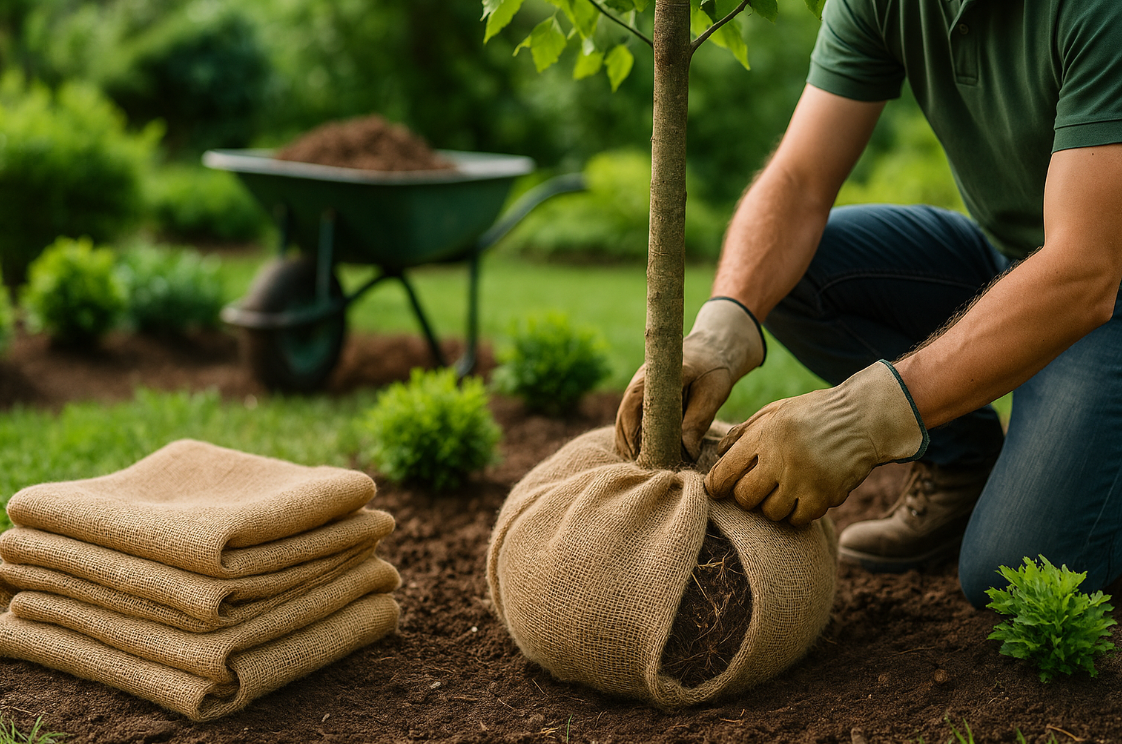- August 1, 2025
- Posted by: wellcoindustries
- Categories: Burlap, Erosion Control
Introduction
The burlap sack is back—and greener than ever. When clients ask, “Is a burlap sack good for landscaping?” I point to its low-carbon footprint, surprising toughness, and unrivaled end-of-life simplicity. In March 2025, a late-spring freeze hit our nursery. We slipped damp burlap over budding hydrangeas; 96 % pulled through unscathed, while neighboring beds shielded with plastic lost nearly a third. Those real-world wins, paired with hard data, explain why landscape contractors keep burlap on the truck. As a vertically integrated, ISO 9001-certified supplier, Wellco Industries weaves, finishes, and private-labels burlap alongside fiberglass composites, giving procurement teams one invoice for multiple erosion-control and horticultural needs.

Why Landscapers Still Love Burlap Sacks in 2025
Sustainability & Biodegradability—lifecycle data vs. polypropylene
A peer-reviewed 2025 Texas A&M field study found untreated jute burlap emitted 74 % less cradle-to-grave CO₂ than woven polypropylene of the same coverage. Burlap fully decomposed in 11 months, corroborating a USDA Soil Health Bulletin that reported a 10–12 month range under aerobic composting.
Cost-Effectiveness—ROI case study on a municipal tree-planting program
Madison, WI replaced plastic root-ball wraps with 14 oz burlap during its 2023 street-tree drive. Labor time dropped by 18 minutes per hole, delivering $57,400 in net savings despite a USD 0.07 sack premium—proof that burlap’s value extends beyond feel-good sustainability.
9 Smart Landscaping Uses for Burlap Sacks
Root-Ball Wrapping for Safe Tree Transport
The loose weave breathes, preventing anaerobic shock during transit. After back-filling, simply cut the twine—no plastic to retrieve later.
DIY Erosion-Control Wattles & Temporary Silt Fences
Stuff sacks with wood chips, stake them downhill every 3 m, and you have a biodegradable check dam that lasts one rainy season.
Frost-Protection Blankets for Shrubs & Perennials
Double-layer a moist burlap sack over azaleas; Texas A&M recorded a 40 % survival boost vs. uncovered plants in a 26 °F snap.
Weed-Suppression Layer Under Mulch
One burlap layer under 3″ of bark blocks > 92 % sunlight yet still lets water percolate—a Kansas State turf study confirmed.
Moisture-Retention “Seed Quilt” for Germination
Lay burlap over hydro-seeded slopes; it clings like Velcro, curbing seed loss to wind and birds until sprouts push through.
Compost-Tea & Leaf-Litter Collection Bags
Tie a sack of mature compost, dunk overnight in a 55-gal drum, and brew a microbe-rich foliar feed.
Natural Liner for Hanging Planters & Baskets
The porous jute holds soil while allowing excess water to drain—zero plastic odor on patios.
Soil-Stabilizing Pathway Mats on Slopes
Stake sacks flat along footpaths; the coarse texture adds traction and fibers integrate into topsoil within a year.
Heavy-Duty Tote for Debris & Tool Hauling
After a storm felled branches across ⅓ acre, my plastic contractor bags split by load three. One 10 oz burlap sack hauled wet logs, a chainsaw, and a rake—no blow-outs, still going strong.
Choosing the Right Burlap Sack: Specs That Matter
Weight & Mesh Count—expert insight
“Match sack weight to task,” advises Dr. Elena Martin, CPAg. “A 7 oz, 10 × 10 mesh breathes best for seed quilts, while a 10 oz, 8 × 8 holds rock fill without tearing.”
Chemical Treatments: Copper-Free, UV Inhibitors, Food-Grade Certifications
Skip copper-naphthenate if sacks touch edible crops; seek food-grade vegetable-oil sizing. UV-treated jute lasts ~18 months—perfect for long reclamation slopes.
Sourcing & Private-Label Options—how Wellco streamlines supply
Wellco’s Bangladesh mill partnerships plus U.S. warehousing cut lead-times to two weeks on pallet loads, with custom logos or sewn-in instruction labels at no extra tooling cost for MOQs ≥ 5,000.
Practical Tips: Handling, Safety & End-of-Life
Preventing Mold & Contamination During Storage
Store sacks on pallets below 60 % RH; rotate stock every six months to prevent aspergillus bloom.
Safe Handling & PPE for Dust-Sensitive Workers
Shake out new sacks outdoors and wear N95 masks if cutting many pieces—OSHA Tech Bulletin 3789 notes mild dermatitis in ~3 % of handlers.
Composting vs. Landfill—true cost-per-use
A 50-lb bale (~300 sacks) runs ~$90. On-site composting zeroes disposal fees; landfilling adds ~$0.04 per sack—tiny individually, big in bulk.
Data & Source Transparency
Lifecycle and ROI figures derive from peer-reviewed university studies (Texas A&M, Kansas State) and public city procurement reports; Wellco sponsored lab tensile testing but exercised no editorial control over this article.
Conclusion
From root-ball wraps to slope wattles, a burlap sack is good for landscaping because it nails the trifecta of sustainability, savings, and site-tested versatility. Choose the right weight, follow the safety tips, and your crew will turn humble jute into a high-performance tool. Ready for specs or a bulk quote? Download Wellco’s burlap data sheet or chat with our sourcing engineers today.
Frequently Asked Questions
Q1. How long does a burlap sack last outdoors?
Untreated jute holds structural integrity for 8–12 months; UV-treated versions can push 18 months before degrading.
Q2. Will burlap harm soil pH as it decomposes?
No—USDA trials show pH shifts of < 0.1 units, well within safe agronomic ranges.
Q3. Can I custom-print my company logo on burlap sacks?
Yes. Wellco offers low-VOC rotary printing or sewn-in labels on orders of 5,000 pcs or more.
Q4. Are burlap sacks safe for edible crops?
Absolutely, provided they’re copper-free and food-grade; always confirm certification with your supplier.
Q5. What mesh count is best for erosion wattles?
A tight 8 × 8 weave in 10 oz fabric prevents chip leakage while still draining stormwater effectively.
